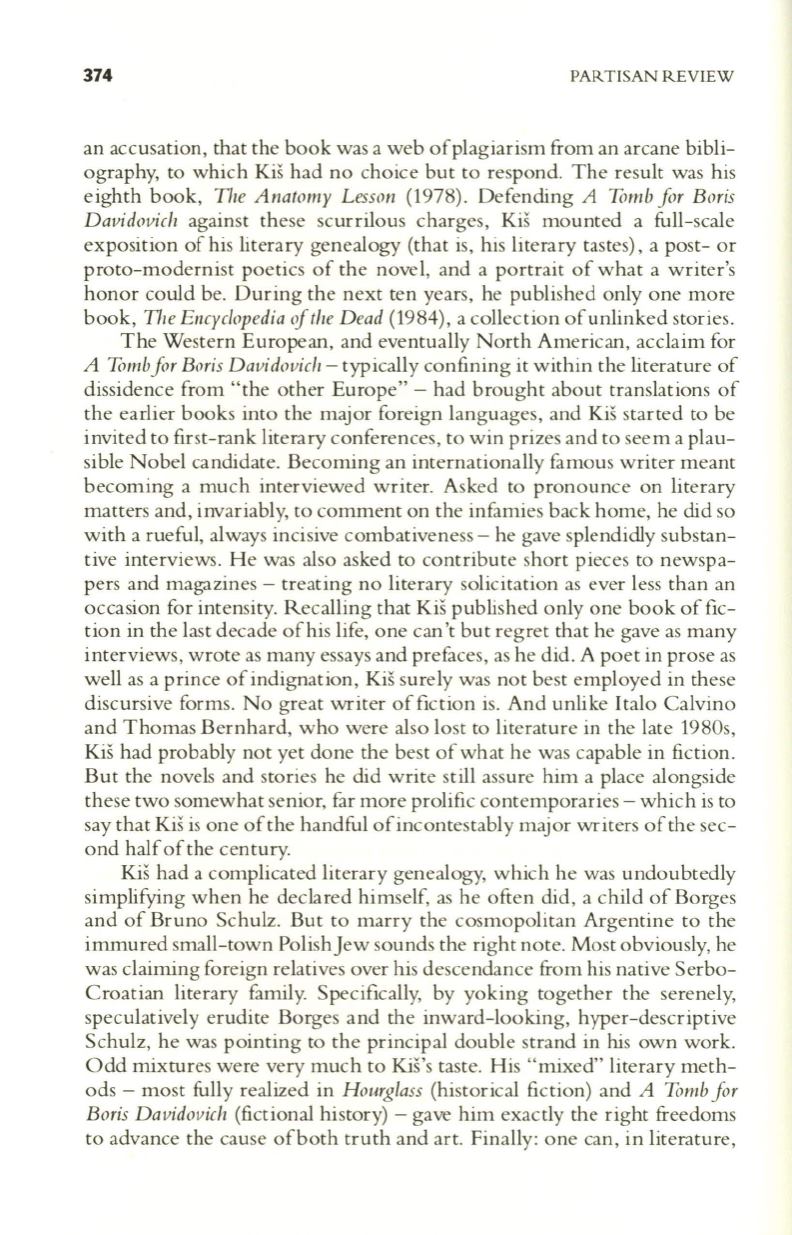
374
PARTISAN REVIEW
an accusation, that the book was a web ofplagiarism from an arcane bibli–
ography, to which Kis had no choice but to respond. The result was his
eighth book,
The Anatomy Lesson
(1978). Defending
A 7i>mb for Boris
Davidovich
against these scurrilous charges, Kis mounted a full-scale
exposition of his literary genealogy (that is, his literary tastes), a post- or
proto-modernist poetics of the novel, and a portrait of what a writer's
honor could be. During the next ten years, he published only one more
book,
TIle Encyclopedia ofthe Dead
(1984), a collection of unlinked stories.
The Western European, and eventually North American, acclaim for
A Tomb for Boris Davidovich
-
typically confining it within the literature of
dissidence from "the other Europe" - had brought about translations of
the earlier books into the major foreign languages, and Kis started to be
invited to first-rank literary conferences, to win prizes and to seem a plau–
sible Nobel candidate. Becoming an internationally famous writer meant
becoming a much interviewed writer. Asked to pronounce on literary
matters and, invariably,
to
comment on the infamies back home, he did so
with a rueful, always incisive combativeness - he gave splendidly substan–
tive interviews. He was also asked to contribute short pieces to newspa–
pers and magazines - treating no literary solicitation as ever less than an
occasion for intensity. Recalling that Kis published only one book of fic–
tion in the last decade of his life, one can't but regret that he gave as many
interviews, wrote as many essays and prefaces, as he did. A poet in prose as
well as a prince of indignation, Kis surely was not best employed in these
discursive forms. No great writer of fiction is. And unlike Italo Calvino
and Thomas Bernhard, who were also lost to literature in the late 1980s,
Kis had probably not yet done the best of what he was capable in fiction .
But the novels and stories he did write still assure him a place alongside
these two somewhat senior, far more prolific contemporaries - which is to
say that Kis is one of the handful ofincontestably major writers of the sec–
ond half of the century.
Kis had a complicated literary genealogy, which he was undoubtedly
simplifying when he declared himself, as he often did, a child of Borges
and of Bruno Schulz. But to marry the cosmopolitan Argentine to the
immured small-town PolishJew sounds the right note. Most obviously, he
was claiming foreign relatives over his descendance from his native Serbo–
Croatian literary family. Specifically, by yoking together the serenely,
speculatively erudite Borges and the inward-looking, hyper-descriptive
Schulz, he was pointing to the principal double strand in his own work.
Odd mixtures were very much to KiS's taste. His "mixed" literary meth–
ods - most fully realized in
Hourglass
(historical fiction) and
A Tomb for
Boris Davidovich
(fictional history) - gave him exactly the right freedoms
to
advance the cause ofboth truth and art. Finally: one can, in literature,


